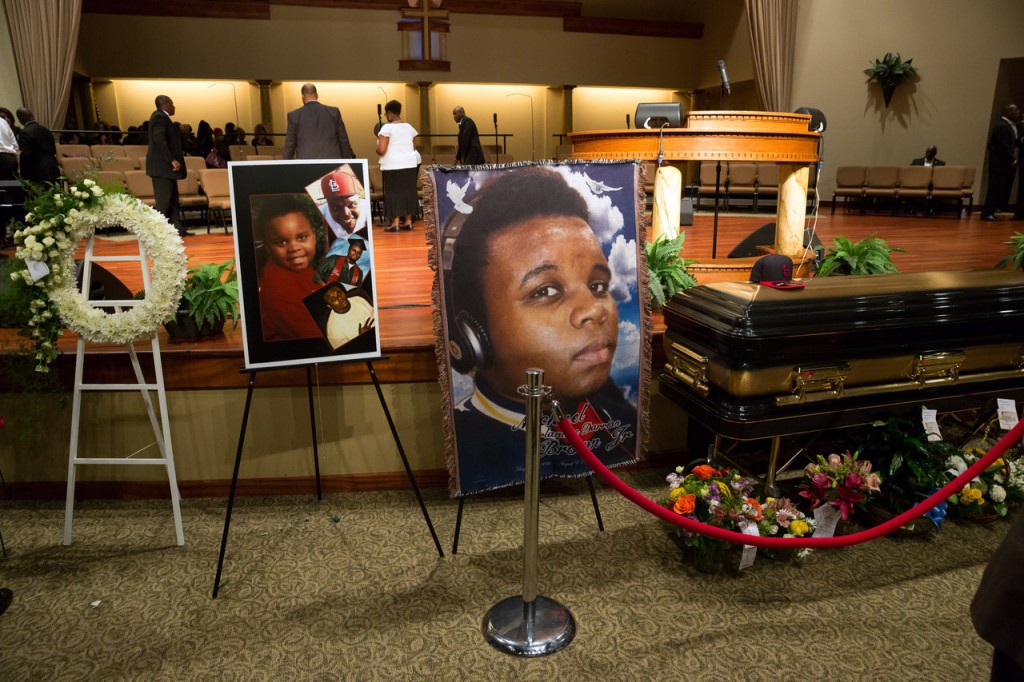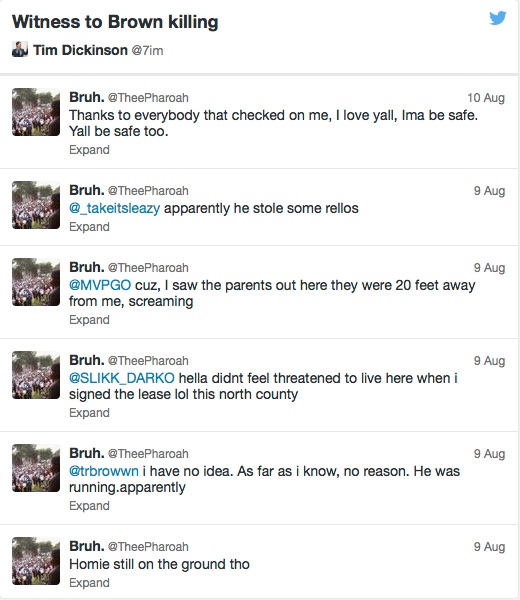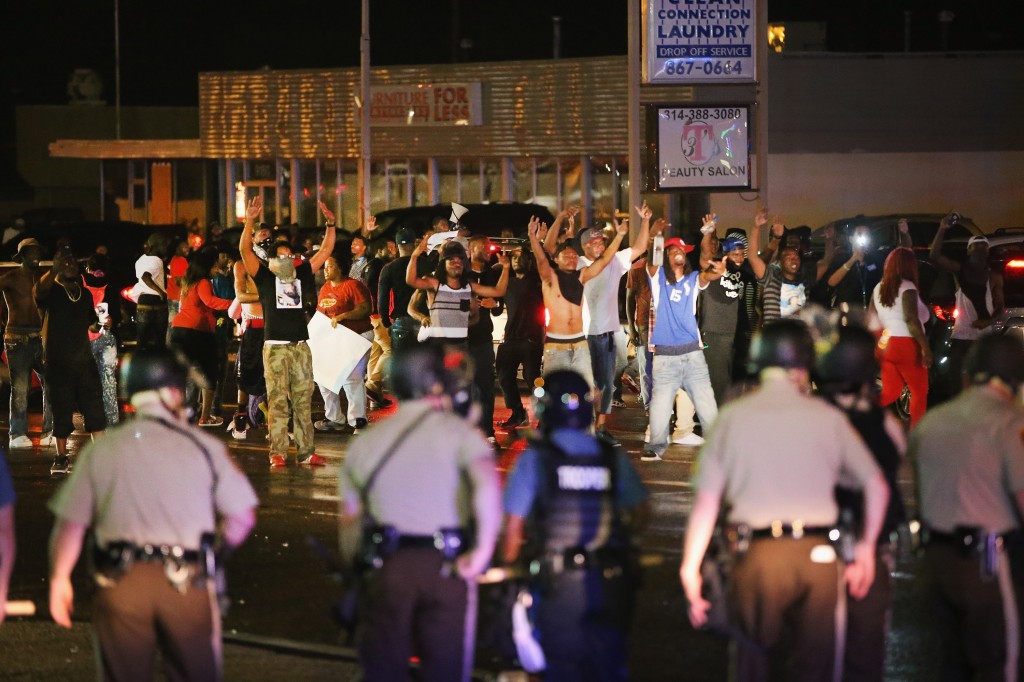SUNDAY, SEPTEMBER 14, 2014
Eyewitnesses agree
Michael Brown was shot
with his hands up
Updated by German Lopez
On September 10 CNN interviewed two newly uncovered eyewitnesses to the August 9 shooting of Michael Brown. The new accounts lined up with what’s been a consistent story among known eyewitnesses in the month after the unarmed 18-year-old was shot and killed by Ferguson, Missouri, police officer Darren Wilson.
There are plenty of rumors floating around about Wilson’s side of the story, but no verified source has given the officer’s detailed account of the fatal shooting. All that’s been offered to the press, officially, is St. Louis County Police Chief Jon Belmar’s abbreviated retelling of Wilson’s version of events — but Belmar left out several pertinent details.
So we don’t really know what Wilson says happened from the beginning of the incident to the end. But eyewitnesses who shared their stories with the media have been rather consistent in their accounts: There appeared to have been a brief struggle between Brown and Wilson. Brown ran from Wilson, who shot at him. After Brown turned and appeared to put his hands up, Wilson fired at him several more times.
Here are the different accounts shared by eyewitnesses and what’s known about Wilson’s side of the story.
1) The two construction workers
The latest eyewitness accounts come from two anonymous construction workers who were caught on tape at the scene of the shooting shortly after Brown’s death. In the video, one of the construction workers said Brown “had his fucking hands in the air” and held his hands up in an imitation of Brown. An unidentified person, who’s off-camera, also shouts that Brown posed no threat to police.
One of the construction workers later told CNN he saw Brown staggering before he fell to his death. He also claimed that Brown put his hands up during the incident and said, “Okay, okay, okay.” According to the worker, Wilson never told Brown to get on the ground, and continued firing.
The other construction worker also told CNN that Brown ran from Wilson during the shooting and held his hands up.
2) Dorian Johnson, Michael Brown’s friend
Johnson, a friend of Brown’s who was with him when he died, gave this account to MSNBC’s Chris Hayes: He and Brown were walking in the middle of the street when Wilson intercepted them and told them to get on the sidewalk. When Wilson tried to get out of his car, the door hit Johnson and Brown and ricocheted into Wilson — upsetting the officer. Wilson grabbed Brown by the neck, and Brown tried to get away. Wilson pulled out his gun and shot Brown. At that point, Brown and Johnson began to run away and the officer fired again. When Brown realized he was hit, he turned around and raised his hands in the air. Wilson approached Brown and fired several more shots.
3) Tiffany Mitchell
Mitchell, who saw the shooting while on her way to pick up someone in the area, gave this account to MSNBC’s Lawrence O’Donnell: There was a struggle between Brown and Wilson, with Brown trying to push away from the police car and Wilson trying to pull Brown into the vehicle. The first gunshot then came from the car, while both of Brown’s hands were outside the vehicle. At that point Brown broke away and started running down the street. Wilson chased after Brown while shooting at the teenager. Brown’s body jerked, as if he was hit, and he turned around, stood still, and put his hands up. Wilson continued shooting Brown even as the teenager attempted to surrender, and Brown went down.
4) Piaget Crenshaw
Crenshaw, who saw the shooting while she was waiting for a ride to work, gave this account to CNN’s Anderson Cooper: Wilson tried to pull Brown into the squad car. When Brown ran away with his back facing the officer, Wilson fired several shots. Brown then turned around and began putting his hands up, and Wilson fired more shots and Brown collapsed.
Crenshaw recorded video after Brown was killed, which she turned over to police.
5) Michael Brady
Brady, who was in his home near the site of the shooting as the events played out, gave this account to CNN’s Anderson Cooper: Brady was in his bedroom when he heard an altercation outside, and he looked out the window. He saw a brief tussle, which lasted roughly 10 seconds, between Brown and Wilson while the officer was still in his squad car. Brown then ran down the street away from the police cruiser. Wilson got out of his car and immediately started firing his weapon at the fleeing teen. At this point, Brady ran out of the house to get a closer look. By the time Brady made it outside, Brown appeared to be wounded and falling to the ground, and Wilson fired three or four more shots.
Brady said he never saw Brown run toward Wilson, but he acknowledged that it could have happened while he was running outside his home.
6) Emanuel Smith
Smith appeared to live-tweet the shooting of Michael Brown. In the tweets, he claimed Brown was running and posed no threat to Wilson when the officer shot him down. Here is a timeline of the tweets, compiled by Rolling Stone’s Tim Dickinson. Be warned that the tweets include pictures of the deceased:
What do police say happened?
The police account — and, by extension, Wilson’s side of the story — remains very unclear.
On August 10, St. Louis County Police Chief Jon Belmar, who’s leading the investigation into Brown’s death,described what happened according to Wilson: Brown physically assaulted Wilson prior to the shooting. Wilson attempted to get out of the car, but Brown pushed him back into the vehicle. Brown then physically assaulted Wilson and attempted to grab the officer’s weapon. At that point, the first shot was fired from the police car. Brown then ran away, and Wilson fired more gunshots and eventually killed Brown about 35 feet from the police car. Wilson was reportedly injured during the encounter and one side of his face was left swollen.
Belmar said he left out details on what Brown did after he ran away so as not to prejudice the investigation into the shooting. Incident reports later released by police were heavily redacted and largely empty, providing few details about the events beyond who, where, and when.
The only other report that purports to tell Wilson’s side of the story is unverified by either Wilson or Ferguson and St. Louis County officials, but it has been embraced by Wilson supporters. It comes from a woman who called into a conservative talk radio show and identified herself simply as “Josie,” a friend of Wilson. She said that Brown charged at Wilson before his death and kept doing so even after multiple shots were fired. She said Wilson took this as a sign that Brown was “on something.” (An autopsy later foundmarijuana in Brown’s system, but there’s no clear evidence that pot causes people to become violent or impervious to gunshots.)
Christine Byers, a crime reporter for the St. Louis Post-Dispatch, later tweeted that police sources told her “more than a dozen witnesses have corroborated cop’s version of events.” But Byers, who was on leave from the paper at the time, later clarified, “Earlier tweets did not meet standards for publication.”
Was the shooting of Michael Brown legal?
In the 1980s, a pair of Supreme Court decisions — Tennessee vs. Garner and Graham v. Connor — set up a framework for determining when deadly force by cops is reasonable.
Constitutionally, “police officers are allowed to shoot under two circumstances,” David Klinger, a University of Missouri-St. Louis professor who studies use of force, told Vox. The first circumstance is “to protect their life or the life of another innocent party” — what departments call the “defense-of-life” standard. The second circumstance is to prevent a suspect from escaping, but only if the officer has probable cause to think the suspect’s committed a serious violent felony.
The logic behind the second circumstance, says Klinger, comes from a Supreme Court decision called Tennessee vs. Garner. That case involved a pair of police officers who shot a 15-year-old boy as he fled from a burglary. (He’d stolen $10 and a purse from a house.) The Court ruled that cops couldn’t shoot every felon who tried to escape. But, as Klinger says, “they basically say that the job of a cop is to protect people from violence, and if you’ve got a violent person who’s fleeing, you can shoot them to stop their flight.”
The key to both of the legal standards — defense-of-life and fleeing a violent felony — is that it doesn’t matter whether there is an actual threat when force is used. Instead, what matters is the officer’s “objectively reasonable” belief that there is a threat.
And what’s “objectively reasonable” changes as the circumstances change. “The moment that you no longer present a threat, I need to stop shooting,” said Klinger. According to the St. Louis County Police Department’s account, Wilson fired one shot from inside the police car. But Brown was killed some 35 feet away, after several shots had been fired. To justify the shooting, Wilson would need to demonstrate that he feared for his life not just when Brown was by the car, but even after he started shooting. The officer would need to establish that, right up until the last shot was fired, he felt Brown continued to pose a threat to him whether he actually was or not.That standard comes from the other Supreme Court case that guides use-of-force decisions: Graham v. Connor. This was a civil lawsuit brought by a man who’d survived his encounter with police officers, but who’d been treated roughly, had his face shoved into the hood of a car, and broken his foot — all while he was suffering a diabetic attack. The court didn’t rule on whether the officers’ treatment of him had been justified, but it did say that the officers couldn’t justify their conduct just based on whether their intentions were good. They had to demonstrate that their actions were “objectively reasonable,” given the circumstances and compared to what other police officers might do.
“One can’t just say, ‘Because I could use deadly force ten seconds ago, that means I can use deadly force again now,'” says Walter Katz, a California attorney who specializes in oversight of law enforcement agencies.




